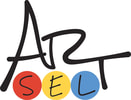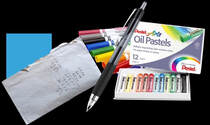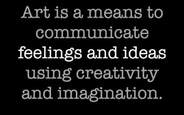Doodle: (du-del) Noun
A casual little drawing done quickly
Some art projects can take hours, days, or months; doodles take as little as a few seconds. Doodles let us explore ideas without the pressure of creating something virtuosic. Just as writers communicate with verbs, nouns, and adjectives, artists communicate with lines, shapes and colors. Creative people often need to work through a lot of ideas quickly and doodles are the perfect tool for this. We can learn how lines, shapes and colors can express ideas and feelings and discuss these things with others.
Supplies |
1. Something to draw on
• Post-It notes • Small pieces of paper 2. Something to draw with • Pencil, pen, marker, oil pastel, crayon 3. Mood meters are available a) 16-word version (Spanish version) b) 100-word version |
Getting Started |
1. Draw 4-6 lines using different energy levels. Do some lines feel unseen? Angry? Lonely? Anxious? Excited? Look at a mood meter and choose a mood that you connect to each line. Write the name of the emotion under each line. Discuss and compare your lines with someone else and appreciate their lines and thoughts.
2. Choose an emotion from each of the four quadrants in the mood meter. Write the name of the emotion on a sticky note first and then draw the line that you feel best represents that emotion. Discuss and compare with someone else. 3. Color can communicate emotions too. A shape is a line that returns to its starting point. Repeat the two exercises above, now choosing the color and shape you feel work best. Here is a beginning slide show and a slightly more advanced one. |
Make It Routine |
1. The mood meters provide 100 lessons-one emotion per day for the first 5 months!
2. The discussion after each creation is as important as the creation itself. 3. How else can doodles be used? Examples:
|
Avoiding Cliché |
Cliché is a French word meaning predictable or overused. If you've seen a symbol or image dozens of times, it's likely "cliché". The key to avoiding cliché is taking the time to think about personal perspective and experiences. For example, instead of a peace sign for "peaceful", think of a time you felt peaceful. What did you see, hear, smell, taste and feel? Take 2-4 mental snapshots of that moment. Now doodle those snapshots. As most artists know, these images may only make sense to you; they are original artworks, not cliché symbols. The discussion or writing about the artwork is as important as the image.
Avoiding cliché slideshow here. |
Sound & Video |
1. Explore doodling to sounds you hear around you, like a sound map.
2. Try doodling your reaction to instrumental music. Here are some selections but any instrumental music can work. Avoid music with words as the words may become what you represent instead of the feelings you are having. 3. Watch videos that show emotions and doodle your impression of how the characters are feeling. Here are some examples |
Drawing with Mr. J |
There are more than 16 videos in the Drawing with Mr. J series. Each is a guided drawing with room for individual choice. Click on the Video Companion to see suggested discussion questions, literature suggestions, and school-home connection ideas. (Example video companion from episode 1) Think about the message of each lesson and how children can go further. How can the child make a new drawing that is connected to their life? Example language: "Think of a person you know or a time when you felt...what drawing are you envisioning now?" As always, the discussion is as important as the image.
|






